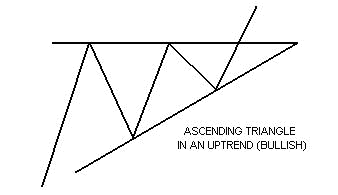|
The ascending triangle is a variation of the symmetrical triangle. Ascending triangles are generally considered bullish and are most reliable when found in an uptrend. The top part of the triangle appears flat, while the bottom part of the triangle has an upward slant. In ascending triangles, the market becomes overbought and prices are turned back. Buying then re-enters the market and prices soon reach their old highs, where they are once again turned back. Buying then resurfaces, although at a higher level than before. Prices eventually break through the old highs and are propelled even higher as new buying comes in. (As in the case of the symmetrical triangle, the breakout is generally accompanied by a marked increase in volume.) (Chart examples of ascending triangle patterns using commodity charts.) (Stock charts.)
Futures and options trading carries significant risk and you can lose some, all or even more than your investment. Stock trading involves high risks and you can lose a significant amount of money. The information contained here was gathered from
sources deemed reliable, however, no claim is made as to its accuracy or
content. This does not contain specific recommendations to buy or sell
at particular prices or times, nor should any of the examples presented
be deemed as such. There is a risk of loss in trading futures and
futures options and stocks and stocks options and you should carefully
consider your financial position before making any trades. The
reference to statistical probabilities does not pertain to
profitability, but rather to the direction of the market. The size and
the duration of the markets move, as well as entry and exit prices
ultimately determines success or failure in a trade and is in no way
represented in these statistics. This is not, nor is it intended
to be, a complete study of chart patterns or technical analysis and
should not be deemed as such. |
